|
 |
THE CANADIAN
SCOTTISH REGIMENT
|
 |
.jpg)
Cap Badge, Shoulder Titles and Collar Badges
of The Canadian Scottish
(Credit for photographs of the badges goes to Clifford Weirmeir, with
his splendid website about
the Irish
regiment of Canada)

This CanScots Helmet Flash Decal was worn on the left
side of the MK II Helmet
In 1920
the Canadian Scottish Regiment was formed with headquarters in
Victoria. In 1927 an alliance was created with The Royal Scots.
From that alliance the Canadian Scottish adopted Hunting Stewart
as the regimental tartan, with uniform patterned after "the
Dandy 9th", the Territorial Army Highland Battalion of The Royal
Scots.


Regimental tartan (left): Hunting Stewart and
the WW2 Pipers tartan (right): Lennox
The 1st
Battalion Canadian Scottish Pipes and Drums served with the
regiment throughout the Second World War. Until 1949 that pipe
band wore Lennox tartan, which was the band tartan of the old
16th Battalion in the First World War. Today one Lennox tartan
ribbon is retained in the full dress uniform of Canadian
Scottish pipers, with the Hunting Stewart kilt and plaid.
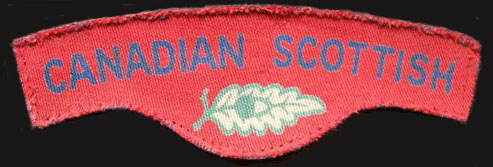
Wartime canvas printed shoulder title of the
Canadian Scottish
Canadian Scottish Pipe Majors 1920 - 1945
1st Battalion, The Canadian
Scottish Regiment
Pipe Major J. Craigmyle 1921 to 1923
Pipe Major W. Wishart 1926 to 1930
Pipe Major A. Wallace 1930 to 1939
Pipe Major J. Marrs 1939 to 1942
Pipe Major A. Pollock 1942 to 1944
Pipe Major A. MacMillan 1944 to 1945
2nd Battalion, The Canadian Scottish Regiment
Pipe Major D. Cameron 1932 to 1939
Pipe Major D. Cameron 1939 to 1943
Pipe Major F. Knight 1943
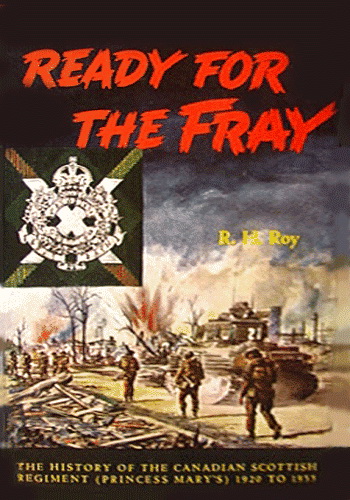
Quotes on this page are given from
"Ready for the Fray", The Regimental History of the Canadian Scottish.
1st. edition printed in Utrecht, Holland right after the war, and the
2nd. revised and enlarged edition which followed in 1958
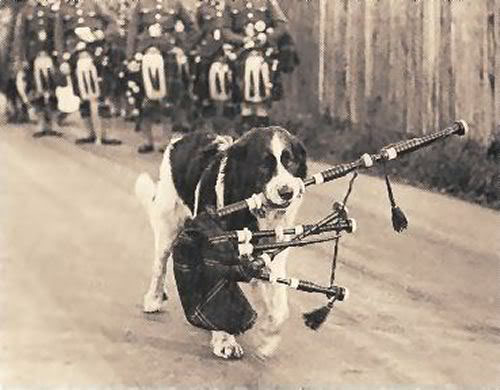
The Saint Bernard "Wallace", CanScots' Pipe Band Mascot during WW2
During WWII, in
June 1940, Wallace (a St. Bernard puppy), the Regimental Mascot
‘enlisted’. A year later, the 1st. Battalion boarded ship for
England along them Wallace (who got smuggled on
board by troops). The ship docked at Glasgow at the
beginning of September when HRH Princess Mary inspected the
Regiment on September 23, 1941. Friendships were struck up with
The Royal Scots, who adopted and kept Wallace in Edinburgh
Castle for the duration of the war. After the war ended Wallace
was reunited with the remaining troops and returned home to
Canada with them. Since then, it's been a unit tradition to have
a St Bernard for the Regimental Mascot.
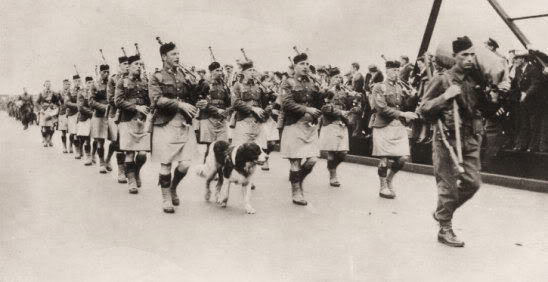
On the way to Training Camp
Debert, Nova Scotia for training,
Canadian Scottish are boarding the
S.S. Princess Elaine,
with Pipes and Drums and their mascot Wallace (J. Marrs still as Pipe Major,
the band wears khaki kilt aprons here)
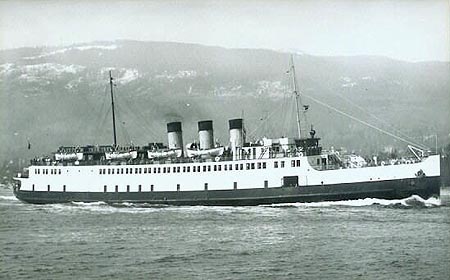
S.S. Princess Elaine
Facts about PRINCESS ELAINE
1928, Built by John Brown & Co. Ltd. Clydebank, Scotland
Length: 291' Beam: 48' Draft: 13' Tonnage: 2027
The most notable new construction of 1928 was the completion in
England and arrival at Vancouver of two new steamships for the
Canadian Pacific B. C. Coast Service. The Princess Elaine,
latest of the handsome C. P. R. three -stackers, arrived from
the John Brown yards on the Clyde in April, entering the
Nanaimo-Vancouver service early in May. A triple-screw turbine
steamer of 2,027 tons, with dimensions of 291.4 x 48. 1 x 13.4,
her 4,600-horsepower turbines gave her a service speed of 19 1/2
knots. She was equipped to handle 60 automobiles in ferry
service, had accommodations for 1,200 day passengers and was
rifted with six staterooms. The Princess Elaine made two round
trips daily with a running time of two hours and 15 minutes each
day. She was commanded by Capt. R. N. Stuart, V. C. 5 Gordon
Newell, "Maritime Events of 1927-28," H.W. McCurdy Marine
History of the Pacific Northwest.. p. 384
"It
was a moving and sombre scene (On October 4,
1940), despite the pipes and Drums of both battalions,
and the recently disbanded brass band of the 1st. battalion
Somehow such tunes as "Roll out the Barrel" did not catch on at
this moment. Many friends of the battalion were there to wish it
Godspeed ... Finally the order was
given, and the men boarded the S.S. Princess Elaine. As the ship
pulled away from the dock, her decks crowded with khaki figures,
the Pipes played "The Skye Boat Song". It was an unforgettable
moment, both for those on the dock and those on the ship. It was
to be five and a half long years before the battalion would come
home. All too many would never make the return journey."

Ready for the Fray, p.92
The 3rd Canadian Infantry division was collected together in
Debert, Nova Scotia on 4 Oct. 1940, where they underwent fairly
severe training for the next year. Those that were lucky enough
got home for leave shortly before the battalion got its orders
to proceed overseas. They left on 25 Aug. 1941 on a beautiful
new ship, the Stratheden, arriving at Glasgow and took up
residence in Salamanca Barracks, Aldershot.

The Stratheden
Facts on
The Stratheden
Built 1937 by Vickers Armstrong, Barrow, as
Stratheden for P&O SN Co.
23,722 grt. 2ST-20 knots.

Ready for the Fray, p.105-106:
Early on the morning of September 1 the men got their first
glimpse of Scotland, and within a few hours the Stratheden, her
railings lined with excited men and with the Pipes and Drums of
the Canadian Scottish playing on the foredeck, sailed up the
Clyde. In a way it was like coming home, a feeling made stronger
by the shrill sound of the pipes and the obvious welcome of the
Scotsmen ashore who, hearing the pipes and seeing the
troop-lined decks of the ships, stopped their work to wave and
shout their greeting. After anchoring off Greenock to await the
tide and, at the same time, to receive greetings from various
dignitaries, the ship sailed up the river to her berth at
Glasgow. There were more greetings here, and none so welcome as
that of Colonel MacKenzie and other representatives of The Royal
Scots. The Depot Pipe Band of The Royal Scots was on the dock to
play a welcome to the Canadian Scottish also, and the pipe bands
combined to play together. It was a happy meeting, and the
gesture on the part of our allied regiment was very much
appreciated. On the following day, when the unit was being piped
ashore, Wallace was taken to assume his rightful position with
the band. Wallace was marvellous "copy" for the pressmen. A few
days later Wallace and the band were publicized in Scottish and
English newspapers. As a result the quarantine authorities
picked up the battalion's mascot. Fame has its price, and for
Wallace the price was six months "C.B." at Oxstead, after which
he rejoined the unit at Denne Park. He was not too lonesome in
the interval, for Piper McGeorge visited him periodically,
bringing some tasty bones as a special treat.
"Ready for the Fray",
p.112-113:
December 1 the battalion was on the move again, arriving at
Paxhill Park in mid-afternoon. As the war diarist continues:
Remainder of the day was spent in unloading trucks, bedding down
in Nissen huts. The division's "Recce" regiment had been at
Denne Park, on the outskirts of Horsham, and it was here,
finally, that the Canadian Scottish moved five days after they
had arrived at Paxhill Park. While the men were busy making the
grounds of Denne Park, formerly the preserve of deer, livable
for soldiers, they were also getting to know Horsham.
The
residents of Horsham were also beginning to accept the Canadian
Scottish, and the sight of the Pipe Band leading the battalion
over the knoll on the north side of Denne Park towards the
Horsham parish church became a familiar sight to them.
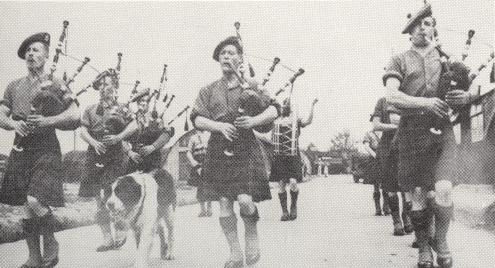
Pipes and Drums with "Wallace", Monk's Common,
England, 1943.
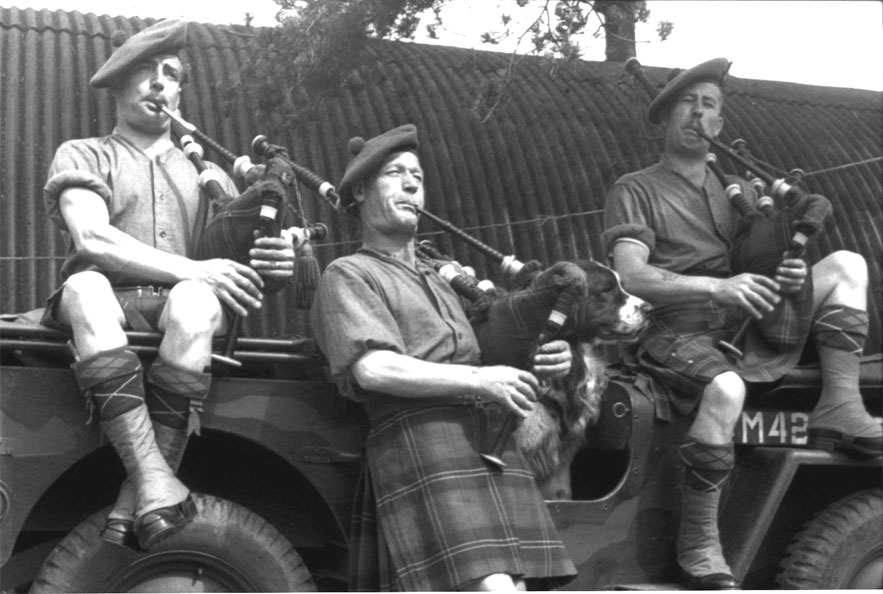
Pipe Major A.J. MacMillan (seated on
the far right) took over and reorganized the CanScots' Pipe Band in 1944
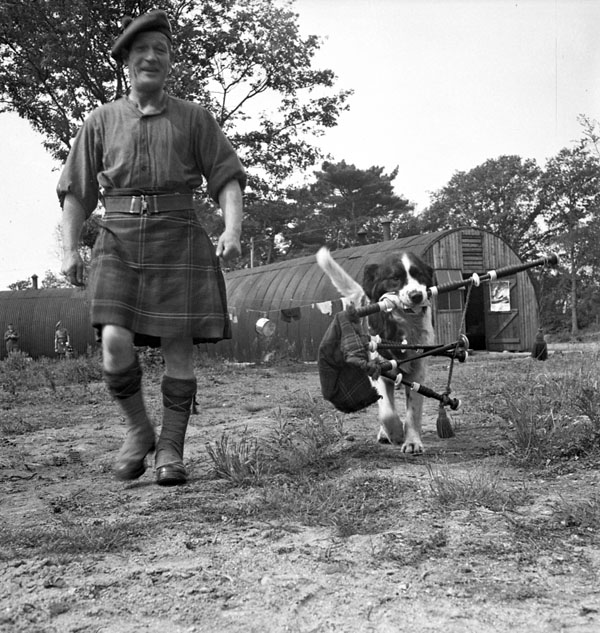
Still in Britain: Wallace would stay
behind for safety, in care of the sister regiment: the Royal Scots,
until the end of the war.
The Canadian
Scottish would have to go ashore on D-day without their Mascot,
but not without their Pipes and drums! For by orders of Lt.Col.
R.G.L. Parker, already on 28th Sept. 1939, the task of pipers
and drummers was outlined thus:
- The Staff
Pipers will make themselves proficient in all Orderly and Band
duties, being particularly responsible for the promotion of
Battalion entertainment, a very important phase of a soldier’s
life. They will assist in the promotion of suitable recreation
and in every way be in the forefront in building up and
maintaining the “Esprit de Corps” of the Battalion. Their
conduct and that of the Company Pipers, both on and off the
parade, will be that of Highland gentlemen, a pattern of
smartness, sobriety and dignity.
- The
Company Pipers and Drummers will make themselves proficient in
their duties as stretcher-bearers, and assist the Staff Pipers
in all matters of entertainment, and will parade as a band with
the Staff Pipers at all times when the Battalion is on the
march. When their respective Companies are at any time on
detached duty they will assume the responsibilities to their
Companies that the Staff Pipers have towards the Battalion as a
whole.
Source:
From the War Diary of the Canadian Scottish Regiment's Pipes &
Drums
MEMBERS OF THE PIPE BAND in HOLLAND:
Pipers :
Pipe Major A.J. MacMillan, L/Cpl. J.G. MacMillan, Piper G.L.
MacMillan, Piper A. McGeorge (S.O.S.), Piper W. Simple, Piper W.
Stephen, Pte. P.S.M. Burtt, Pte. H.E. McEwan, Pte. D. Miller,
Pte. J.A. Stout, Pte. J.A. Stephen, Pte. A.C. Waterton, Pte. D.
Leask
Drummers :
A. Howie -Bass, J.G. Naysmith -Tenor, A.M. Knight -Side, D.D.
Knight -Side, J.O. Auger -Side, J. Daubs -Tenor, C. Poole -Side,
R.A. Bono -Side, V. Poole -Side
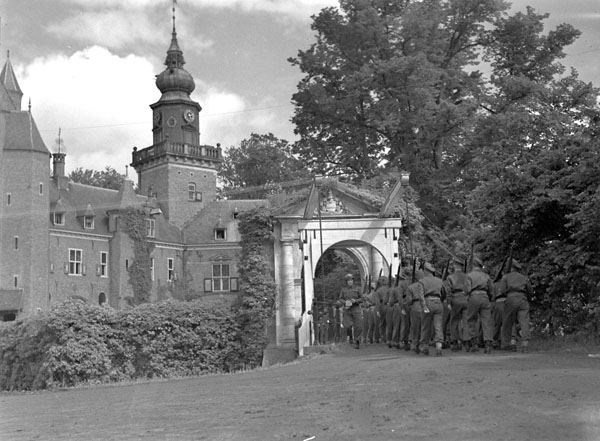
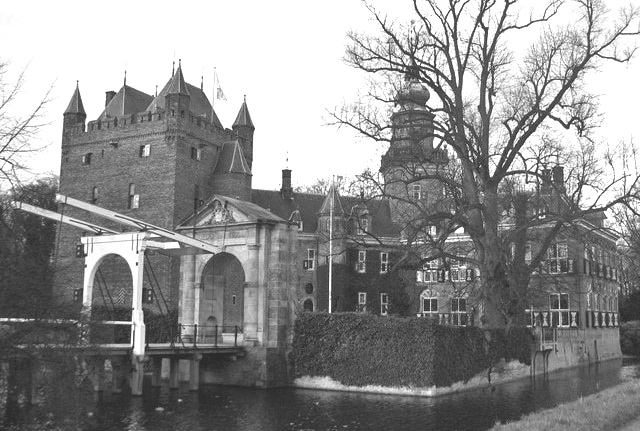
This beautiful Castle "Nijenrode"
became the new temporary 'home away from home' for the Canadian Scottish

Ready for the Fray, p.434:
About a week after the cease fire, word was received that the
brigade was going to leave Germany and concentrate in an area
north-west of Utrecht in Holland. After an inspection on May 14
by Lieutenant-General Simonds (the dawn of a new
era of spit-and-polish was already visible through the rising
mist of paper-work) the battalion left on the following
day for its three-day, 300-mile journey to southern Holland.
When
it arrived as its destination, the Canadian Scottish quickly
found that, if it was free of Germany, it was certainly not free
of Germans. The brigade's task was to take care of approximately
8,000 German troops, and of this number the Canadian Scottish
was assigned about 2,700 who were encamped in the grounds of a
castle, the "Huis te Nijenrode". These German troops, part of
the 149th Division of the 88th Corps, had their own officers and
headquarters staffs, the Canadians being responsible for their
custody and ensuring that they conformed to the laws laid down
for their behaviour by higher authority.
When this task was
finished, the CanScots were moved to Ede for a special
commemorative task.
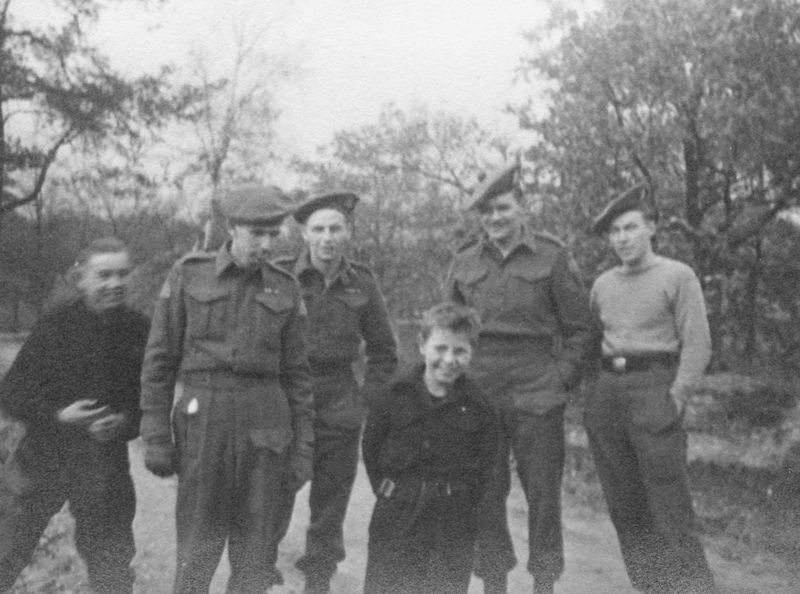
Canadian Scottish with some youthful
Dutch fans, at the construction site of the Ede Memorial park
Before the battalion left Ede on November 9, there was a special
parade to celebrate the opening of the Ede Memorial Park. This
park had been a brigade work project for months. A plaque
containing unit crests and dedicated to those in the Dutch
Underground who gave their lives during the war was unveiled at
the same time. Later in the day Stompekamp Park, transformed
from a stump lot into a green playing field for children by the
Canadian Scottish, was officially turned over to the citizens of
Ede. It had been a pleasure, for a change, to work on such a
project, and at the same time it served to show the appreciation
of the battalion for the wonderful hospitality of their Dutch
neighbours.
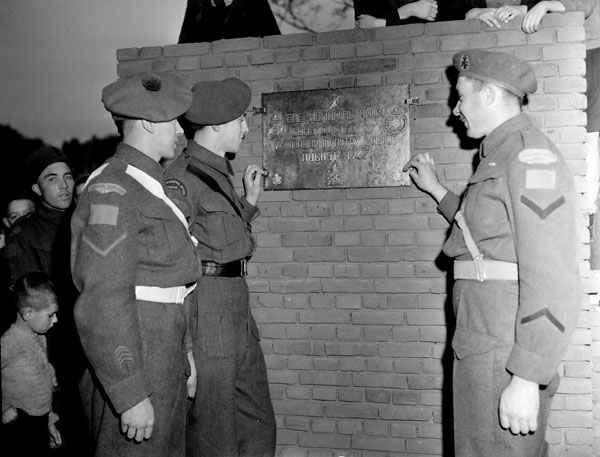
Canadian soldiers examining the
Memorial Park Plaque, Ede, Netherlands
(L-R): Lance-Corporal L.H. Smith, 1st Battalion,
The Canadian Scottish Regiment; Lance-Corporal J.T. Adams, The
Royal Winnipeg Rifles; Lance-Corporal Peter Tarnowski, Regina
Rifle Regiment.
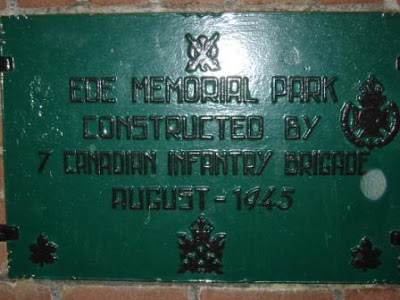
And as it does look now,
after all those years
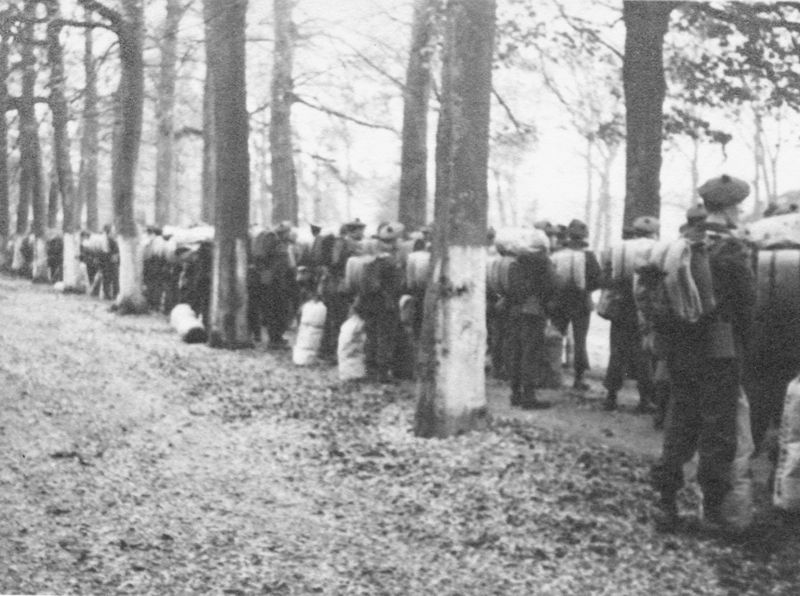
The
trip from Ede through Nijmegen to Calais, then to Aldershot took
only four days. Two weeks' leave, which for some meant two weeks
with their families, was followed by a short period of intense
"square bashing" in preparation for the inspection by the
Colonel-in-Chief on December 4.
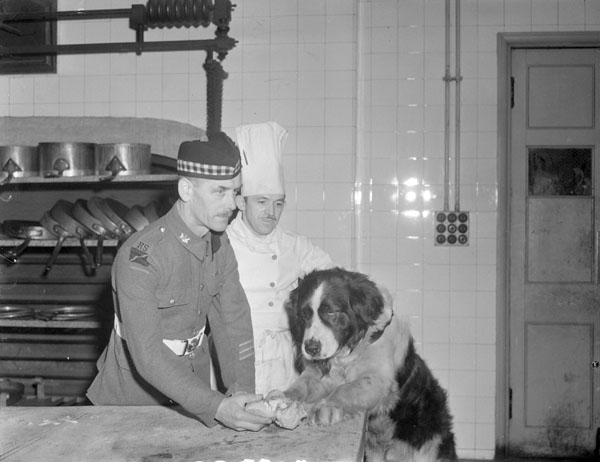
Wallace, the mascot of the 1st
Battalion, The Canadian Scottish Regiment, now still with the Royal
Scots in Britain,
being fed at a ceremonial dinner at the Mansion House attended by H.R.H.
the Princess Royal,
before being handed over back to the Canadian Scottish who would take
him back to Canada. London, England, 6 December 1945
The
highlight of the battalion's return to England, however, came on
the following day when 100 officers and men, led by the Pipe
Band with "Wallace" in the van, marched through London to the
Mansion House.

The Pipe
Band in 1945 (showing the Pipers' Red Lennox
Tartan), marching through London to the Mansion House,
escorted by mascot Wallace I, under the direction of Pipe Major
Archie McMillan
The Canadian
Scottish sailed from Southampton on board the Queen Elizabeth three days
before Christmas

RMS Queen
Elizabeth
Details on the
R.M.S. Queen Elizabeth
Gross Tonnage - 83,673 tons - Dimensions - 300.94
x 36.14m (987.4 x 118.6ft)
Number of funnels - 2 - Number of masts - 2 - Construction -
Steel
Propulsion - Quadruple screw - Engines - Single reduction steam
turbines
Service speed - 29 knots - Builder - John Brown & Co Ltd,
Glasgow
Launch date - 27 September 1938
Passenger accommodation - 823 1st class, 662 cabin class, 798
tourist class
In 1942 the Admiralty drew up plans to convert the two Queens
into aircraft carriers but these were later abandoned as it was
considered that their troop carrying role was too important.
In April 1942 the Queen Elizabeth relocated from Sydney to New
York. Here the troop accommodation was altered to make its
capacity 10,000. In June 1942 it began to make voyages from New
York to Gourock and then to Suez, via Cape Town. In August it
began a shuttle service between New York and Gourock. Despite
the ever present threat of U-boats the ship continued its
service unscathed, although the German press stated that a
U-boat had hit the vessel with a torpedo on 11 November. By the
end of the war in Europe the Queens had brought over a million
troops to the war zone. The ship's next duty was to repatriate
these troops and redeploy troops for the war against Japan. The
repatriation of American troops continued until October 1945
when the Queen Elizabeth was released from US service and
allocated to the repatriation of Canadian troops. On 6 March
1946 it arrived back in Southampton and was released from
Government service as the need for troop movements had
diminished. During the war it had carried over 750,000 troops
and travelled 500,000 miles.
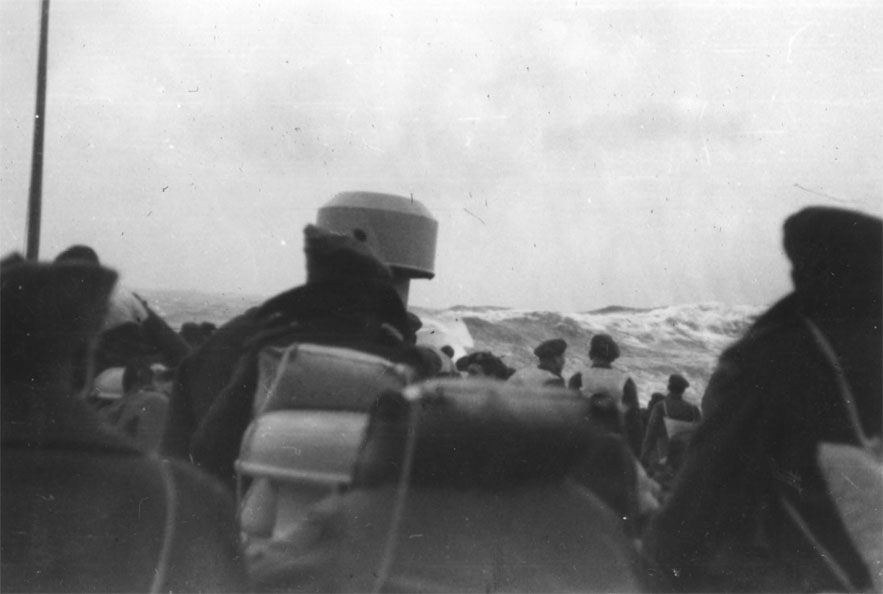
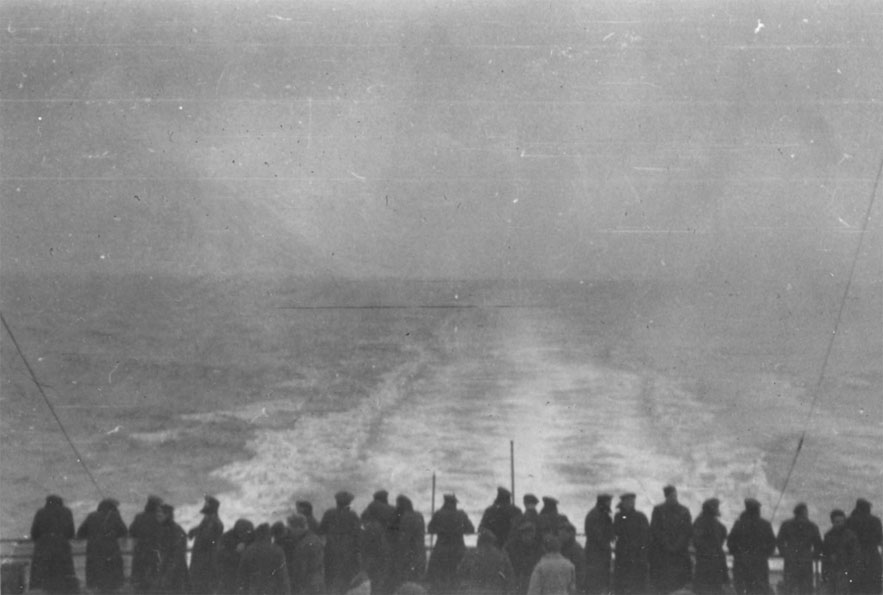
Going Home on board of The Queen Elisabeth,
December 1945
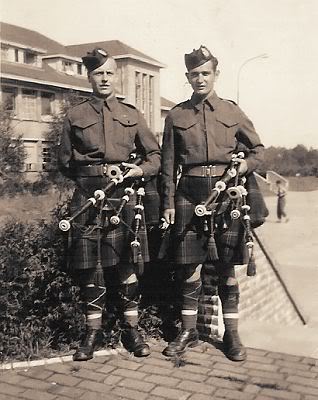
Two pipers from the 4th battalion
Pipe band
Those who stayed behind: THE 4th/1st BATTALION, CANADIAN ARMY
OCCUPATION FORCE
When
the Canadian Scottish sailed from Southampton on board the Queen
Elizabeth three days before Christmas, there remained in Europe
a battalion bearing the regimental name. This was the 4th/1st
Battalion, The Canadian Scottish Regiment, Canadian Army
Occupation Force. This battalion, although bearing the
regimental title, contained but a small percentage of ex-members
of the regiment.
The 4th Battalion Pipe Band was
formed in the fall of 1945, while on occupational duty in NW
Germany. There were 2 pipers, including Jim Stout, from the 1st
Battalion C Scot R and another from the Canadian Highland Light
Infantry. There was also a side drummer and a bass/tenor
drummer.
Lt. Col. Larry Henderson wished to
have a complete band to come home with. They obtained Henderson
practice chanters, Logan’s tutors and drum sticks from ordnance
and later Stark pipes and rope tension drums. By the time they
were set to go home (8 or 9 months later) there were 12 pipers,
5 side drummers, 2 tenors and a bass. They expected to go to
Victoria upon arrival home but got as far as Vancouver where
they went their separate ways. They never played as a band on
Canadian soil
The
end of the occupational role for the Canadian Scottish came on
April 21, 1946, when the 4th/1st Battalion boarded the T.S.S.
Clan Lamont at Cuxhaven, Germany. On the following day the unit
landed at London's Tilbury Docks and was taken to No. 4
Repatriation Depot at Witley Camp, a short distance from
Farnborough. There the battalion was broken up into "wings",
with the "wings" corresponding to the military districts in
Canada where the men would be discharged.
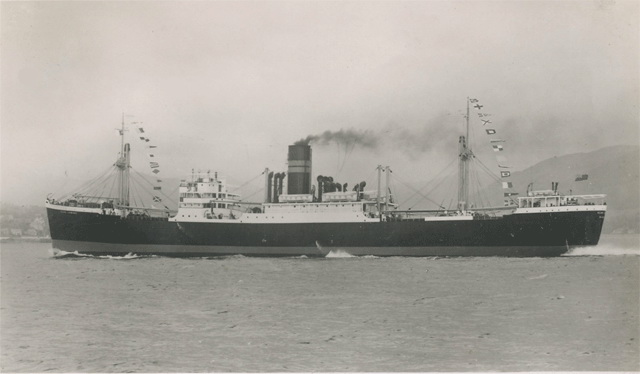
T.S. Clan Lamont

 |